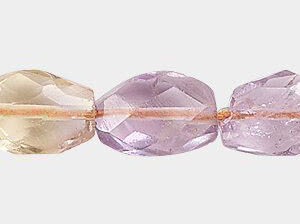Ametrine Meaning and Properties
Ametrine History
Ametrine is a combination of amethyst and citrine, which are both a variety of quartz. Amethyst is clear quartz with the presence of manganese, making it purple. Citrine is clear quartz with the presence of iron, making it golden yellow. Quartzes (such as amethyst, citrine, ametrine and others) have been around for millennia and make up approximately 12% of the Earth's crust.
Ametrine was not readily available on the market until the 1970s, when it was discovered—or re-discovered—in Bolivia. The legends say a Spanish conquistador discovered the ametrine mine in the 1600s, when he received the land after marrying a native princess named Anahi. He sent several specimens to Queen Isabella of Spain … and then the mine was lost for centuries. When it was rediscovered, it was named after the legendary princess, whose land it once was.
The Anahi mine produces natural amethyst, citrine and ametrine.
What are the Metaphysical Properties of Ametrine?
Ametrine meaning is often tied to harmony, combining the calming energy of amethyst with the energizing power of citrine. This gemstone is believed to relieve tension, boost creativity and promote emotional balance and clarity. Ametrine meaning also includes spiritual growth, inner strength and enhanced decision-making. Seen as a powerful detoxifier, it’s said to clear negative energy and align the mind, body and spirit for overall well-being.
What is Ametrine Made From?
Ametrine is a macrocrystalline variety of quartz that occurs rarely in nature.
For ametrine to occur naturally, iron impurities—combined with differing oxidation states—are subjected to varied temperatures. For ametrine to be formed in nature, temperatures need to be slightly higher on some of the surfaces, slightly cooler on others, and the delicate balance of the two temperatures would need to be maintained during the crystallization of the quartz.
Simulated ametrine is created when amethyst is subjected to the same type of conditions in the lab, turning purple areas various shades of yellow. Most ametrine in the market today is heat-treated amethyst.
- Mineral Information: Macrocrystalline quartz
- Chemical Composition: SiO2
- Color: Golden sunlight yellow blended with lavender/purple
- Hardness: 7 (Mohs)
- Specific Gravity: 2.6 - 2.7
- Refractive Index: 1.544 - 1.553
How Do You Clean Ametrine?
This stone is fairly hard, so you can use an ultrasonic cleaner with it. As most ametrine is created using heat treatments, steam cleaning is not recommended. Store ametrine in a cool, dark place to prevent it from losing color in the sunlight due to both heat and light. Regular gentle cleaning also helps preserve its shine.
Ametrine FAQ
Q: What causes the dual coloration in ametrine?
A: Ametrine’s unique blend of purple and golden hues is caused by differing oxidation states of iron within the crystal. Natural temperature changes during the stone’s formation result in both amethyst (purple) and citrine (yellow) colors in the same quartz crystal.
Q: Are there any inclusion or visible flaws in ametrine?
A: Ametrine is typically quite transparent, especially in high-quality specimens. While minor inclusions can occur, most gem-grade ametrine is eye-clean, meaning flaws aren’t visible without magnification. Any inclusions present usually don’t affect the stone’s durability or beauty.
Q: Does the cut of the gemstone affect the way the colors blend?
A: Yes! A skilled cutter can enhance or balance the contrast between the purple and yellow zones. Step and emerald cuts often showcase the sharp color transition, while fancy cuts may create a more blended, gradient or artistic appearance, depending on the stone’s natural zoning.
Q: Is ametrine suitable for daily use in a bracelet?
A: With a Mohs hardness of 7, ametrine is fairly durable, but can scratch or chip if exposed to harsh knocks. Since bracelets are more prone to impact, this stone is best for occasional wear or in protected settings.
Designing with Ametrine
Ametrine comes in a variety of shades from pale lavender to a deep purple to yellow-purple to yellow-orange. Paralleling its colors, ametrine is stunning combined with rainbow fluorite, citrine pearls or lavender amethyst. Depending on its color saturation, it can be mixed with muted hues such as blue lace agate and rose quartz, or with deep jewel tones such as iolite and spinel. Being a mix of warm and cool tones, ametrine works well with both gold and silver.
Shop for Ametrine
**Please note that all metaphysical or healing properties listed are collected from various sources. This information is offered as a service and not meant to treat medical conditions. Fire Mountain Gems and Beads® does not guarantee the validity of any of these statements.
How did you like this resource? Your feedback helps us provide resources that matter to you most.
Copyright Permissions
All works of authorship (articles, videos, tutorials and other creative works) are from the Fire Mountain Gems and Beads® Collection, and permission to copy is granted for non-commercial educational purposes only. All other reproduction requires written permission. For more information, please email copyrightpermission@firemtn.com.

